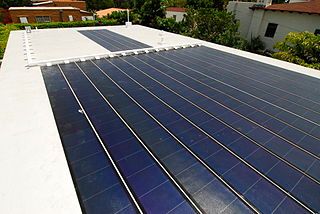Thin Film Solar Breaks Efficiency Record

I certainly don’t track every element of technological progress that the clean energy industry makes, but I occasionally take note, as it serves as a reminder of the big picture. The sun bestows more energy on the Earth in 90 minutes than all seven billion of us are consuming in a full year. All we need is a cost-effective solution that captures that tiny fraction, and the game will be over. No more environmental damage from burning fossil fuels. No more dangers of nuclear accidents and issues with waste disposal.
Today’s quantum leap in efficiency is just another reminder of how truly close we are. The quality is rising, and the costs are falling. Sounds good to me.

“Here, we just achieved 16.1%, a huge increase from the former record holder at 14.7%.”
Although that is a significant increase, it is less than 10% which certainly is not huge.
All we need to do to get reliable and plentiful power from the sun is to have a single solar farm, perhaps 200 miles wide, completely encircling the earth. Perhaps in the future, advances in technology will make that possible.
If it were a few miles above the earth and spinning to counteract gravity, somewhat like one of Saturn’s rings, it wouldn’t need to be so wide because there would be no clouds to shade it. However, there could be some technical problems with using slip rings connected to power lines to bring the power down to the earth’s surface.
The most exciting thing about First Solar’s leap from a record module at 14.4% to one at 16.1% is that this is fact that as far as I know, this panel was not the result of a remote science lab experiment, but rather a refined product the refinements in which are designed for transfer to the company’s production facilities.
As all the steps in the production of this champion panel are designed for transfer to the production line, there is a good chance that standard panel efficiencies will rise rapidly with little or no change in bill of materials, and with relatively affordable modifications to the production system.
If I am right on this, the cost per watt of making First Solar’s panels could well drop by around 10% to 15% in the next couple of years (disregarding other cost improvements from design refinement, production line cost effectiveness etc), whilst also causing very nearly as much reduction in the cost of an installed system through lower land requirements, less cable and support frame, and less labour arising from more watts per panel.
Here’s a nice little chart of historical progrees in efficiency for various PV technologies:
http://www.nature.com/am/journal/v2/n3/fig_tab/am201082f3.html#figure-title